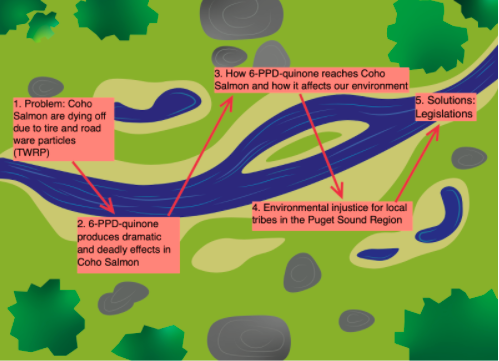
Figure 1. An overview of how tire and road wear particles can affect local species and tribes in the Puget Sound Region. Created by Ishika Kapoor.
Introduction
Many species worldwide have been facing the consequences of toxicants in our environment. The coho salmon, Oncorhynchus kisutch is one of the five Pacific salmon species and is also considered to be a native species to the Pacific Northwest. Coho salmon return to local creeks with the purpose of reproducing (Tian et al. 2021). Recent studies have shown that the local species die off due to tire and road wear particles (TWRP) (Baltruschat 2019). Most TWRP contain heterogeneous particles that are absorbed on road surfaces, aquatic environments, and soil (Baltruschat 2019). Research has found that annual stormwater exposure has been increasing mortality rates among many aquatic species like coho salmon (Gaffield 2003). The runoff found in the stormwater is connected to the toxic chemicals found in tires and road wear. Tires are made of additional functional rubber, these include certain curing agents and antioxidants (Unice et al. 2015). Researchers have narrowed down three common tire chemicals that can possibly be responsible for the mortality rate in coho salmon CBS, 6-PPD, DPG (Unice et al. 2015).
Environmental injustice can be defined as unequal exposure of pollution in communities of color and the poor, and its collateral effects on health and the environment. It also includes disproportionate environmental protection and quality from laws and legislation (Maantay 2002). In the Puget Sound, the Coast Salish people are one of the victims of environmental injustice. The Coast Salish territory not only contains many groups but spans throughout many regions. The territory neighbors the Puget Sound (Figure 2), extends to the Gulf of Georgia and surrounds southeastern Vancouver Island and the Southern mainland of British Columbia (AMNH 2015). Coho salmon is a main part of the Coast Salish peoples diet (Thom 2003). This article focuses on specifically N-(1,3-dimethylbutyl)-N’-phenyl-1,4-phenylenediamine (6-PPD), commonly known as 6PPD-quinone and its ripple effect on species and people in the Puget Sound.
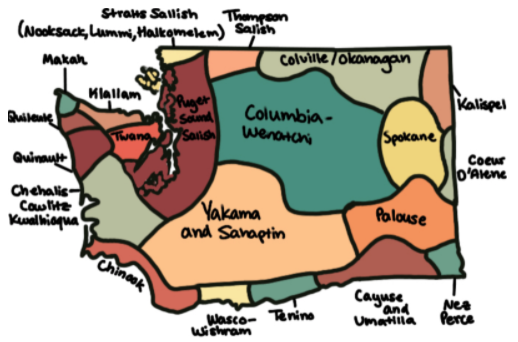
Figure 2. A hand drawn map of tribes located in the state of Washington. Created by Summer Turnberg.
6-PPD-quinone Produces Dramatic and Deadly Effects for Coho Salmon
In Washington, the coho salmon are listed as endangered under the Endangered Species Act (Bell et al. 2003). The toxic effect of 6PPD-quinone can dramatically affect the physiology of salmon (Dunagan 2021). This is why fully understanding the effects of this tire chemical on salmon as well as other species can lead to an increase in research attention. Along with federal and state authorities who can better develop recovery plans for the threatened and endangered salmon along the west coast.
When the coho are exposed to the toxicant they can become lethargic, they can lose their sense of equilibrium, become immobile and/or experience surface respiration (Mclntyre et al. 2018). This is because when fish open their mouth water rushes in with toxicant. Their gills try to filter the water with the toxicant to digest the ions/food within the water and then lastly release the water. Unfortunately when the toxicant is present, it gets metabolized along with the other ions/food instead of flowing back out with the water (Parenti 2021). Understanding the effects of pollutants can provide further insight and awareness for people who consume salmon from toxic waters.
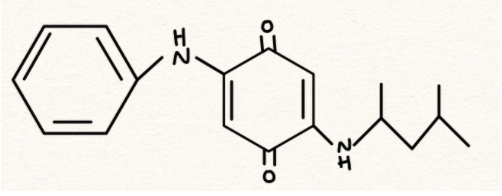
Figure 3. Handmade chemical structure of 6PPD quinone (C18H24N2) by Summer Turnberg.
The Toxicant and How It Affects the Environment
6PPD is an antioxidant used in rubber production which is lethal to salmon when it runs off into waters populated with the coho salmon. An image of 6PPD has been provided in figure 3. 6PPD-quinone was the unknown contaminant that the team or researchers needed to discover after the rapid decline in coho salmon had been observed and identified as acute toxicity (Tian et al 2021). Via environmental and analytical chemistry, a team of scientists discovered that the mystery contaminant at hand was in fact 6PPD-quinone. With this knowledge, they connected 6PPD-quinone to the nearby road and the river that ran by it. The connection was made that it was the tires of the car on the road that were causing this contamination (Unice et al 2015). As 6PPD-quinone has not been regulated, new and old tires contain the compound and threaten the livelihood of coho salmon.
Tire pollutants from new and weathered tires with a high ability to reside in the soil (Unice et al 2015). Further, nearly all vehicles have a threat level to the coho salmon population due to the lack of proper regulation. 6PPD-quinone has environmental release factors in sediment and in water, therefore serving as a double exposure to the coho Salmon through sediment and water contamination from the compound (Unice et al 2015).
Through filtration, the salmon are exposed to 6PPD and even small traces of this pollutant were lethal to coho salmon in the lab setting (Stokstad). A diagram of the contamination making its way to the coho salmon population is provided in figure 4.

Figure 4. Diagram of contaminants with 6PPD from tires contaminating sediment and water. (Free photo: Car, Smart Car, Wheels, transportation, no people, tire, outdoors 2019), (Dszc et al., Riverbank Pictures, images and stock photos). Created by Summer Turnberg.
Environmental Injustice
The Coast Salish people consume coho salmon actively in July-December. They also may store and save the coho salmon, meaning consumption may continue past the most common months. The decline in the salmon population directly affects the traditional diets and dependencies on culturally relevant food (Traditional animal foods of indigenous peoples of northern North America). Environmental justice is defined as, “…the fair treatment and meaningful involvement of all people regardless of race, color, national origin, or income with respect to the development, implementation and enforcement of environmental laws, regulations and policies” by the United States Environmental Protection Agency (EPA). Additionally, the salmon has a large presence in the culture of the Coast Salish peoples. Below is a quote from Chief Weninock of the Yakima tribe:
“My strength is from the fish; my blood is from the fish, from the roots and berries. The fish and game are the essence of my life. I was not brought from a foreign country and did not come here. I was put here by the Creator.”
—Chief Weninock, Yakama, 1915 (Tribal Salmon Culture)
The tire contaminants directly affect the cultural food and of the Coast Salish people, and their cultural identity is threatened by the lack of regulation on 6PPD quinone. Access to culturally relevant foods and protecting the coho salmon in the South Sound area must be of utmost importance as it is an injustice and an environmental threat. A pyramid showing the span of this issue is included in figure 5.
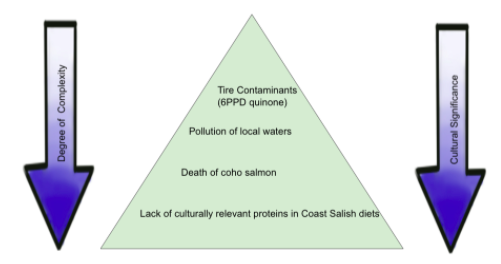
Figure 5. Pyramid of the issues surrounding environmental justice with 6PPD quinone killing off Coho Salmon populations. Figure created by Summer Turnberg.
Legislations and Future Directions
The recent research for 6PPD- quinone has gained the attention of the Washington State government. $718,000 has been funded to the 6PPD-quinone project with $195,000 going towards assessment efforts of the toxicant and $523,000 going towards management projects for runoff (Dunagan 2021). With the completed research, scientists are moving forward to developing these solutions. Possible solutions could be creating tires that are more environmentally favorable. One idea researchers are working on right now is finding an alternative chemical to use in tires. There are 5 classes of chemicals being tested now, they are in their second year of a four-year test (Dunagan 2021).
Another possible way to eliminate the effects of this contamination is by implementing stormwater treatment. This can be seen with rain gardens. Figure 6 examines the treatment of stormwater through a rain garden. Though these gardens do require an initial investment, they are a natural and effective way to help avoid contamination of urban water.
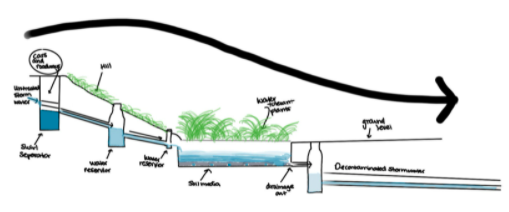
Figure 6. Stormwater decontamination model. Created by Summer Turnberg, inspired by UWT’s Stormwater on Campus Sustainability.
With the current funding, there is a great capacity for change. It is our hope that the Washington State Legislature eliminates 6PPD-quinone and the alternatives being researched can be utilized. With this, the environmental injustice suppressing the Coast Salish peoples can begin to be diminished and as a society, we can work towards equity to those most affected by the premature killing of the coho salmon due to our urban contaminant: 6PPD-quinone.
Work Cited:
Bell KP, Huppert D, Johnson RL. 2003. Willingness to Pay for Local Coho Salmon Enhancement in Coastal Communities. Marine Resource Economics. 18(1):15–31. doi:10.1086/mre.18.1.42629381.
Coast Salish. 2015. AMNH. [accessed 2021 Nov 21] https://www.amnh.org/exhibitions/permanent/northwest-coast/coast-salish.
Common tire chemical implicated in mysterious deaths of at-risk salmon. www.science org. [accessed 2021 Nov 30]. Available from: https://www.science.org/content/article/common-tire-chemical-implicated-mysterious-deaths-risk-salmon.
Dunagan C, Georgiadis N. Discovery of tire-related chemical that kills Coho Salmon Sparks widespread response. Puget Sound Institute. 2021 Aug 26 [accessed 2021 Nov 30]. Available from:https://www.pugetsoundinstitute.org/2021/08/discovery-of-tire-related-chemical-that-kills-coho-salmon-sparks-widespread-response/
Dszc, Lysne C, Lanolan, bear_mark68, Lakefx, Anderson M, Yue_, Eloi_Omella, AleksandarNakic, Blueringmedia, et al. Riverbank Pictures, images and stock photos. iStock. [accessed 2021 Nov 6]. Available from: https://www.istockphoto.com/photos/riverbank
EPA. [accessed 2021 Nov 6]. Available from: https://www.epa.gov/environmentaljustice/learn-about-environmental-justice
Free photo: Car, Smart Car, Wheels, transportation, no people, tire, outdoors. Hippopx. 2019. [accessed 2021 Nov 6]. Available from: https://www.hippopx.com/en/car-smart-car-wheels-transportation-no-people-tire-outdoors-25533
Gaffield SJ, Goo RL, Richards LA, Jackson RJ. 2003. Public Health Effects of Inadequately Managed Stormwater Runoff. American Journal of Public Health. 93(9):1527–1533. doi: 10.2105/ajph.93.9.1527
Maantay J. 2002. Mapping environmental injustices: pitfalls and potential of geographic information systems in assessing environmental health and equity. Environmental Health Perspectives. 110(suppl 2):161–171. doi:10.1289/ehp.02110s2161.
McIntyre JK, Lundin JI, Cameron JR, Chow MI, Davis JW, Incardona JP, Scholz NL. 2018. Interspecies variation in the susceptibility of adult Pacific salmon to toxic urban stormwater runoff. Environmental Pollution. 238:196–203. doi:10.1016/j.envpol.2018.03.012.
Tribal Salmon Culture. Columbia River Inter-Tribal Fish Commission. 2016 Apr 7 [accessed 2021 Nov 30]. https://www.critfc.org/salmon-culture/tribal-salmon-culture/
Salmon | Traditional Animal Foods of Indigenous Peoples of Northern North America – Animals – Fish – Searun Fish. traditionalanimalfoodsorg. [accessed 2021 Nov 6]. Available from: http://traditionalanimalfoods.org/fish/searun-fish/page.aspx?id=6446#coho-e.
Stormwater on campus: Sustainability. University of Washington Tacoma. [accessed 2021 Nov 30]. https://www.tacoma.uw.edu/fa/facilities/sustainability/stormwater-campus
Tian Z, Zhao H, Peter KT, Gonzalez M, Wetzel J, Wu C, Hu X, Prat J, Mudrock E, Hettinger R, et al. 2021. A ubiquitous tire rubber-derived chemical induces acute mortality in coho salmon. Science (American Association for the Advancement of Science). 371(6525):185–189. doi:10.1126/science.abd6951.
Thom B. 2003. Contemporary & Desired Use of Traditional Resources in a Coast Salish Community: Implications for Food Security and Aboriginal Rights in British Columbia. [accessed 2021 Nov 26]. Available from: http://citeseerx.ist.psu.edu/viewdoc/download?doi=10.1.1.495.6891&rep=rep1&type=pdf
Unice KM, Bare JL, Kreider ML, Panko JM. 2015. Experimental methodology for assessing the environmental fate of organic chemicals in polymer matrices using column leaching studies and OECD 308 water/sediment systems: Application to tire and road wear particles. Science of The Total Environment. 533:476–487. doi:10.1016/j.scitotenv.2015.06.053.
Bell KP, Huppert D, Johnson RL. 2003. Willingness to Pay for Local Coho Salmon Enhancement in Coastal Communities. Marine Resource Economics. 18(1):15–31. doi:10.1086/mre.18.1.42629381. Coast Salish. 2015. AMNH. [accessed 2021 Nov 21] https://www.amnh.org/exhibitions/permanent/northwest-coast/coast-salish. Common tire chemical implicated in mysterious deaths of at-risk salmon. http://www.science org. [accessed 2021 Nov 30]. Available from: https://www.science.org/content/article/common-tire-chemical-implicated-mysterious-deaths-risk-salmon. Dunagan C, Georgiadis N. Discovery of tire-related chemical that kills Coho Salmon Sparks widespread response. Puget Sound Institute. 2021 Aug 26 [accessed 2021 Nov 30]. Available from:https://www.pugetsoundinstitute.org/2021/08/discovery-of-tire-related-chemical-that-kills-coho-salmon-sparks-widespread-response/ Dszc, Lysne C, Lanolan, bear_mark68, Lakefx, Anderson M, Yue_, Eloi_Omella, AleksandarNakic, Blueringmedia, et al. Riverbank Pictures, images and stock photos. iStock. [accessed 2021 Nov 6]. Available from: https://www.istockphoto.com/photos/riverbank EPA. [accessed 2021 Nov 6]. Available from: https://www.epa.gov/environmentaljustice/learn-about-environmental-justice Free photo: Car, Smart Car, Wheels, transportation, no people, tire, outdoors. Hippopx. 2019. [accessed 2021 Nov 6]. Available from: https://www.hippopx.com/en/car-smart-car-wheels-transportation-no-people-tire-outdoors-25533 Gaffield SJ, Goo RL, Richards LA, Jackson RJ. 2003. Public Health Effects of Inadequately Managed Stormwater Runoff. American Journal of Public Health. 93(9):1527–1533. doi: 10.2105/ajph.93.9.1527 Maantay J. 2002. Mapping environmental injustices: pitfalls and potential of geographic information systems in assessing environmental health and equity. Environmental Health Perspectives. 110(suppl 2):161–171. doi:10.1289/ehp.02110s2161. McIntyre JK, Lundin JI, Cameron JR, Chow MI, Davis JW, Incardona JP, Scholz NL. 2018. Interspecies variation in the susceptibility of adult Pacific salmon to toxic urban stormwater runoff. Environmental Pollution. 238:196–203. doi:10.1016/j.envpol.2018.03.012. Tribal Salmon Culture. Columbia River Inter-Tribal Fish Commission. 2016 Apr 7 [accessed 2021 Nov 30]. https://www.critfc.org/salmon-culture/tribal-salmon-culture/ Salmon | Traditional Animal Foods of Indigenous Peoples of Northern North America - Animals - Fish - Searun Fish. traditionalanimalfoodsorg. [accessed 2021 Nov 6]. Available from: http://traditionalanimalfoods.org/fish/searun-fish/page.aspx?id=6446#coho-e. Stormwater on campus: Sustainability. University of Washington Tacoma. [accessed 2021 Nov 30]. https://www.tacoma.uw.edu/fa/facilities/sustainability/stormwater-campus Tian Z, Zhao H, Peter KT, Gonzalez M, Wetzel J, Wu C, Hu X, Prat J, Mudrock E, Hettinger R, et al. 2021. A ubiquitous tire rubber-derived chemical induces acute mortality in coho salmon. Science (American Association for the Advancement of Science). 371(6525):185–189. doi:10.1126/science.abd6951. Thom B. 2003. Contemporary & Desired Use of Traditional Resources in a Coast Salish Community: Implications for Food Security and Aboriginal Rights in British Columbia. [accessed 2021 Nov 26]. Available from: http://citeseerx.ist.psu.edu/viewdoc/download?doi=10.1.1.495.6891&rep=rep1&type=pdf Unice KM, Bare JL, Kreider ML, Panko JM. 2015. Experimental methodology for assessing the environmental fate of organic chemicals in polymer matrices using column leaching studies and OECD 308 water/sediment systems: Application to tire and road wear particles. Science of The Total Environment. 533:476–487. doi:10.1016/j.scitotenv.2015.06.053.

Provide Feedback